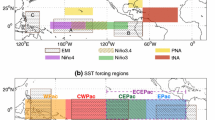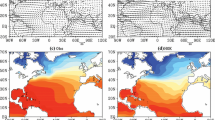Abstract
Influence of North Atlantic sea surface temperature (SST) anomalies on tropical Pacific SST anomalies is examined. Both summer and winter North Atlantic SST anomalies are negatively related to central-eastern tropical Pacific SST anomalies in the subsequent months varying from 5 to 13 months. In particular, when the North Atlantic is colder than normal in the summer, an El Niño event is likely to be initiated in the subsequent spring in the tropical Pacific. Associated with summer cold North Atlantic SST anomalies is an anomalous cyclonic circulation at low-level over the North Atlantic from subsequent October to April. Corresponded to this local response, an SST-induced heating over the North Atlantic produces a teleconnected pattern, similar to the East Atlantic/West Russia teleconnection. The pattern features two anticyclonic circulations near England and Lake Baikal, and two cyclonic circulations over the North Atlantic and near the Caspian Sea. The anticyclonic circulation near Lake Baikal enhances the continent northerlies, and strengthens the East-Asian winter monsoon. These are also associated with an off-equatorial cyclonic circulation in the western Pacific during the subsequent winter and spring, which produces equatorial westerly wind anomalies in the western Pacific. The equatorial westerly wind anomalies in the winter and spring can help initiate a Pacific El Niño event following a cold North Atlantic in the summer.













Similar content being viewed by others
References
Annamalai H, Xie S-P, McCreary JP, Murtugudde R (2005) Impact of Indian Ocean sea surface temperature on developing El Niño. J Clim 18:302–319
Barnett TP (1983) Interaction of the monsoon and Pacific trade wind system at inter-annual time scales. Part I: the equatorial zone. Mon Weather Rev 111:756–773
Barnston AG, Livezey RE (1987) Classification, seasonality and persistence of low-frequency atmospheric circulation patterns. Mon Weather Rev 115:1083–1126
Chan JCL, Zhou W (2005) PDO, ENSO and the summer monsoon rainfall over South China. Geophys Res Lett 32:L08810
Chu P-S (1988) Extratropical forcing and the burst of equatorial westerlies in the western Pacific: a synoptic study. J Meteorol Soc Jpn 66:549–564
Chu P-S, Frederick J (1990) Westerly wind bursts and surface heat fluxes in the equatorial western Pacific in May 1982. J Meteorol Soc Jpn 68:523–537
Clarke AJ, Shu L (2000) Quasi-biennial winds in the far western equatorial Pacific phase-Locking El Niño to the seasonal cycle. Geophys Res Lett 27(6):771–774
Clarke AJ, Van Gorder S (2001) ENSO prediction using an ENSO trigger and a proxy for western equatorial Pacific warm pool movement. Geophys Res Lett 28:579–582
Czaja A, Frankignoul C (2002) Observed impact of Atlantic SST anomalies on the North Atlantic Oscillation. J Clim 15:606–623
Dong BW, Sutton RT (2002) Adjustment of the coupled ocean–atmosphere system to a sudden change in the thermohaline circulation. Geophys Res Lett 29(15):1728. doi:10.1029/2002GL015229
Dong BW, Sutton RT (2007) Enhancement of ENSO variability by a weakened Atlantic thermohaline circulation in a coupled GCM. J Clim 20:4920–4939
Dong BW, Sutton RT, Scaife AS (2006) Multidecadal modulation of El Niño-Southern Oscillation (ENSO) variance by Atlantic Ocean sea surface temperatures. Geophys Res Lett 33:L08705. doi:10.1029/2006GL025766
Enfield D, Mestas-Nunez A, Trimble P (2001) The Atlantic multidecadal oscillation and its relation to rainfall and river flows in the continental US. Geophys Res Lett 28:2077–2080
Gong D-Y, Wang S-W, Zhu J-H (2001) East Asian winter monsoon and Arctic oscillation. Geophys Res Lett 28(10):2073–2076
Hoskins BJ, Ambrizzi T (1993) Rossby wave propagation on a realistic longitudinally varying flow. J Atmos Sci 38:1179–1196
Huang R, Zang X, Zhang R, Chen J (1998) The westerly anomalies over the tropical pacific and their dynamical effect on the ENSO cycles during 1980–1994. Adv Atmos Sci 15:135–151
Jhun J-G, Lee E-J (2004) A new East Asian winter monsoon index and associated characteristics of the winter monsoon. J Clim 17:711–726
Knight JR, Folland CK, Scaife AA (2006) Climate impacts of the Atlantic multidecadal oscillation. Geophys Res Lett 33:L17706. doi:10.1029/2006GL026242
Kug J-S, Kang I-S (2006) Interactive feedback between ENSO and the Indian Ocean. J Clim 19:1784–1800
Kug J-S, An S-II, Jin F-F, Kang I-S (2005) Preconditions for El Niño and La Niña onsets and their relation to the Indian Ocean. Geophys Res Lett 32:L05706. doi:10.1029/2004GL021674
Kushnir Y (1994) Interdecadal variations North Atlantic Sea surface temperature and associated atmospheric conditions. J Clim 7:141–157
Latif M, Arpe K, Roeckner E (2000) Oceanic control of decadal North Atlantic sea level pressure variability in winter. Geophys Res Lett 27:727–730
Li C (1990) Interaction between anomalous winter monsoon in East Asia and El Niño events. Adv Atmos Sci 7:36–46
Li C, Pei S, Pu Y (2005) Dynamical impact of anomalous East-Asian winter monsoon on zonal wind over the equatorial western Pacific. Chin Sci Bull 50:1520–1526
Li Y, Lu R, Dong BW (2007) The ENSO–Asian monsoon interaction in a coupled ocean–atmosphere GCM. J Clim 20:5164–5177
Lu R, Li Y, Dong BW (2007) Arctic oscillation and Antarctic oscillation in internal atmospheric variability with an ensemble AGCM simulation. Adv Atmos Sci 24:152–192
Luther D, Harrison D, Knox R (1983) Zonal wind in the central equatorial Pacific and El Niño. Science 202:327–330
Mann M, Park J (1994) Global-scale modes of surface temperature variability on interannual to century timescales. J Geophys Res 99:25819–25833
McPhaden MJ (1999) Genesis and evolution of the 1997–1998 El Niño. Science 283:950–954
Misra V (2004) The teleconnection between the western Indian and the western Pacific Ocean. Mon Weather Rev 132:445–455
Nakamura H (1994) Rotational evolution of potential vorticity associated with a strong blocking flow configuration over Europe. Geophys Res Lett 21:2003–2006
Nakamura H, Nakamura M, Anderson JL (1997) The role of high- and low-frequency dynamics in the blocking formation. Mon Weather Rev 125:2074–2093
Nakamura T, Tachibana Y, Honda M, Yamane S (2006) Influence of the Northern Hemisphere annular mode on ENSO by modulating westerly wind bursts. Geophys Res Lett 33:L07709. doi:10.1029/2005GL025432
Philander SG (1985) El Niño and La Niña. J Atmos Sci 42:2652–2662
Plumb RA (1985) On the three-dimensional propagation of stationary waves. J Atmos Sci 42:217–229
Rasmusson EM, Carpenter TH (1982) Variations in tropical sea surface temperature and surface wind fields associated with the Southern Oscillation/El Niño. Mon Weather Rev 110:354–384
Rayner NA, Parker DE, Horton EB, Folland CK, Alexander LV, Rowell DP, Kent EC, Kaplan A (2003) Global analyses of sea surface temperature, sea ice, and night marine air temperature since the late nineteenth century. J Geophys Res 108:4407. doi:10.1029/2002JD002670
Rodwell MJ, Rowell DP, Folland CK (1999) Oceanic forcing of the wintertime North Atlantic Oscillation and European climate. Nature 398:320–323
Sutton RT, Hodson DLR (2007) Climate response to basin-scale warming and cooling of the North Atlantic Ocean. J Clim 20:891–907
Thompson DWJ, Lorenz DJ (2004) The signature of the annular modes in the tropical troposphere. J Clim 17:4330–4342
Timmermann A, An S-I, Krebs U, Goosse H (2005) ENSO suppression due to weakening of the North Atlantic thermohaline circulation. J Clim 18:3122–3139
Trenberth KE (1997) The definition of El Niño. Bull Am Meteorol Soc 78:2771–2777
Trenberth KE, Hurrell JW (1994) Decadal atmosphere–ocean variations in the Pacific. Clim Dyn 9:303–319
Wallace JM, Gutzler DS (1981) Teleconnections in the geopotential height field during the Northern Hemisphere winter. Mon Weather Rev 109:784–812
Wang B, An S-I (2002) A mechanism for decadal changes of ENSO behavior: roles of background wind changes. Clim Dyn 18:475–486
Wang C, Weisberg RH (2000) The 1997–1998 El Niño evolution relative to previous El Niño events. J Clim 13:488–501
Wang B, Zhang Q (2002) Pacific–East Asian teleconnection. Part II: how the Philippine Sea anomalous anticyclone is established during El Niño development. J Clim 15:3252–3265
Wang C, Weisberg RH, Virmani J (1999) Western Pacific interannual variability associated with the El Niño-Southern Oscillation. J Geophys Res 104:5131–5149
Wang B, Wu R, Fu X (2000) Pacific–East Asian teleconnection: how does ENSO affect East Asian climate? J Clim 13:1517–1536
Wang D, Wang C, Yang X, Lu J (2005) Winter Northern Hemisphere surface air temperature variability associated with the Arctic Oscillation and North Atlantic Oscillation. Geophys Res Lett 32:L16706. doi:10.1029/2005GL022952
Wang X, Wang D, Zhou W (2009) Decadal variability of twentieth-century El Niño and La Niña occurrence from observations and IPCC AR4 coupled models. Geophys Res Lett 36:L11701. doi:10.1029/2009GL037929
Weisberg RH, Wang C (1997a) Slow variability in the equatorial west-central Pacific in relation to ENSO. J Clim 10:1998–2017
Weisberg RH, Wang C (1997b) A western Pacific oscillator paradigm for the El Niño-Southern Oscillation. Geophys Res Lett 24:779–782
Wu BY, Wang J (2002) Possible impacts of winter Arctic Oscillation on Siberian high, the East Asian winter monsoon and sea-ice extent. Adv Atmos Sci 19:297–320
Wyrtki K (1975) El Niño-the dynamic response of the equatorial Pacific Ocean to atmospheric forcing. J Phys Oceanogr 5:572–584
Xie S-P, Annamanlai H, Schott FA, McCreary JP (2002) Structure and mechanisms of south Indian Ocean climate variability. J Clim 15:864–878
Xie S-P, Hu K, Hafner J, Tokinaga H, Du Y, Huang G, Sampe Y (2009) Indian Ocean capacitor effect on Indo-western Pacific climate during the summer following El Niño. J Clim 22:730–747
Xu J, Chan JCL (2001) The role of the Asian/Australian monsoon system in the onset time of El Niño events. J Clim 14:418–433
Zhang R, Delworth TL (2005) Simulated tropical response to a substantial weakening of the Atlantic thermohaline circulation. J Clim 18:1853–1860
Zhou W, Li C, Wang X (2007a) Possible connection between Pacific Oceanic interdecadal pathway and East Asian winter monsoon. Geophys Res Lett 34:L01701. doi:10.1029/2006GL027809
Zhou W, Wang X, Zhou TJ, Li CY, Chan JCL (2007b) Interdecadal variability of the relationship between the East Asian winter monsoon and ENSO. Meteorol Atmos Phys 98:283–293. doi:10.1007/s00703-007-0263-6
Acknowledgments
This work is supported by the Chinese Academy of Sciences (grant KZCX2-YW-214), the Natural Science Foundation of China (grants U0733002 and 40906010), and the MOST of China (grant 2006CB403604). The work of Xin Wang is supported by City University of Hong Kong Research Scholarship Enhancement Scheme and the City University of Hong Kong Strategic Research Grants 7002329.
Author information
Authors and Affiliations
Corresponding author
Rights and permissions
About this article
Cite this article
Wang, X., Wang, C., Zhou, W. et al. Teleconnected influence of North Atlantic sea surface temperature on the El Niño onset. Clim Dyn 37, 663–676 (2011). https://doi.org/10.1007/s00382-010-0833-z
Received:
Accepted:
Published:
Issue Date:
DOI: https://doi.org/10.1007/s00382-010-0833-z




